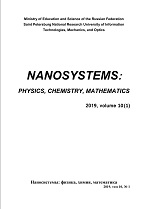|
This article is cited in 1 scientific paper (total in 1 paper)
PHYSICS
Performance enhancement of triboelectric nanogenerator using iodine doped PVDF
Rohit Phogaata, Venkatesh Yepurib
a Amity Institute of Nanotechnology, Amity University Haryana, Haryana, India
b Swarnandhra College of Engineering and Technology, Seetharampuram, Narsapur, India
Abstract:
Because of the rapid improvement of energy collecting technologies, unique mechanical devices have been created. As a result of the energy problems, however, researchers began to create new procedures and strategies for storing as much energy as feasible. Nanotechnology is unique, and it spurred the invention of Triboelectric Nanogenerators (TENGs), which are employed as a source of energy in wearables by transforming mechanical energy into electrical energy. This article discusses TENG, which is a triboelectric material made from Polyvinylidene fluoride (PVDF) and aluminium (Al). TENG may be made in two ways: with PVDF alone or with iodine doped PVDF, with Al staying the same in the both cases. Despite the fact that the materials are triboelectric, aluminium electrodes are utilised to attach to the materials, which are created on a plastic substrate using a thermal evaporator and taped together. The existence of PVDF was verified by the Fourier transform infrared spectroscopy (FTIR) examinations, which revealed high absorption peaks at 723 cm$^{-1}$ and 849 cm$^{-1}$, respectively. The digital storage oscilloscope (DSO) and pico- ammeter (10–12 m) measurements of the TENG device’s output voltage and current yielded results of 25V and 8 pA, respectively. Additionally, this study reveals the power density produced and the distinctiveness of this TENG device, both of which are critical to the efficiency and applicability of TENG in a new generation of electronics.
Keywords:
doping, iodine, Polyvinylidene fluoride (PVDF), Polyethylene terephthalate (PET), Triboelectric Nanogenerator (TENG).
Received: 21.12.2022
Revised: 02.01.2023
Accepted: 03.01.2023
Citation:
Rohit Phogaat, Venkatesh Yepuri, “Performance enhancement of triboelectric nanogenerator using iodine doped PVDF”, Nanosystems: Physics, Chemistry, Mathematics, 14:1 (2023), 69–73
Linking options:
https://www.mathnet.ru/eng/nano1163 https://www.mathnet.ru/eng/nano/v14/i1/p69
|

|




 Contact us:
Contact us: Terms of Use
Terms of Use
 Registration to the website
Registration to the website Logotypes
Logotypes








 Citation in format
Citation in format 
